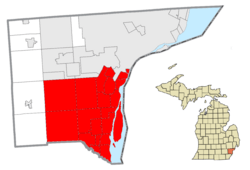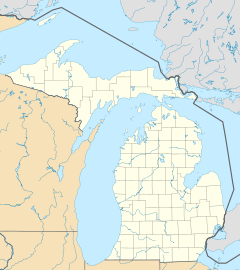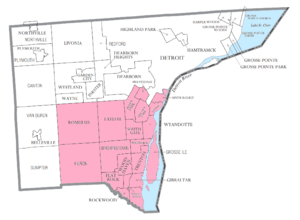Downriver facts for kids
Quick facts for kids
Downriver
|
|
|---|---|

Communities within Wayne County that are included as part of the Downriver community
|
|
| Country | United States |
| State | Michigan |
| County | Wayne |
| Cities | Ecorse, Gibraltar, River Rouge, Riverview, Trenton,Wyandotte |
| Townships | Brownstown, Grosse Ile, Huron |
| Area | |
| • Total | 213.09 sq mi (551.9 km2) |
| • Land | 190.94 sq mi (494.5 km2) |
| • Water | 22.15 sq mi (57.4 km2) |
| Population
(2010)
|
|
| • Total | 466,577 |
| • Density | 1,866.8/sq mi (720.8/km2) |
| Time zone | UTC-5 (Eastern (EST)) |
| • Summer (DST) | UTC-4 (EDT) |
| ZIP code(s) |
48101, 48111, 48122, 48134, 48138, 48146, 48164, 48173, 48174, 48180, 48183, 48192, 48193, 48195, 48218, 48229, 48242
|
| Area code(s) | 313 and 734 |
| Congressional districts | 5th, 6th, and 13th |
Downriver is a special area in the Detroit metropolitan area in Michigan, USA. It includes many towns in Wayne County. These towns are located south of the city of Detroit, right along the western side of the Detroit River.
Contents
Why is it Called Downriver?
The name "Downriver" comes from how the Detroit River flows. The river first runs west along Detroit and Windsor, Ontario. Then, it turns and flows mostly south before it reaches Lake Erie.
So, if you travel along the river from Detroit, you go "downriver" to reach these communities. That's how they got their name! Sometimes, people in these towns have different feelings about the "Downriver" name.
A Look Back at Downriver's History
In the early 1900s, Downriver was a busy place. Many people worked in factories that made cars, steel, and chemicals. Big companies like the Ford Rouge Plant Complex were here.
Over time, the types of jobs changed. Now, more people work in office jobs. The area has also grown with new homes and better roads. This makes it easier for people to travel to work.
Some southern parts of Downriver, like Brownstown Township, used to be mostly farms. Today, these areas have more homes, but you can still find some farms.
Today, Downriver is known as a suburban area of Detroit. It has many neighborhoods and fun outdoor activities. You can enjoy boating, fishing, and watching birds along the Detroit River. The Detroit River International Wildlife Refuge is a great place for nature lovers. There are also many trails for walking and biking.
The News-Herald is a local newspaper that shares news about the Downriver area.
Exploring Downriver Communities
Downriver is made up of several towns and townships. Here are some of them:
- Allen Park
- Ecorse
- Grosse Ile Township
- Lincoln Park
- River Rouge
- Riverview
- Southgate
- Taylor
- Trenton
- Woodhaven
- Wyandotte
How Downriver Communities Are Different
The communities closer to Detroit, like Allen Park and Wyandotte, grew in the 1920s-1940s. They often have brick homes and tree-lined streets.
Towns further south, such as Southgate and Taylor, grew later, from the 1950s-1970s. These areas have more modern housing developments. Some areas like Huron Township still have farms.
Several Downriver cities are right on the Detroit River. These include Ecorse, Gibraltar, and Trenton. Grosse Ile is a unique island community in the middle of the river.
Downriver communities have their own special feel. However, some towns also share similarities with other Detroit suburbs.
Taylor is the largest city in the Downriver area by population. It has a college campus, a large shopping mall called Southland Center, and a sports complex. Taylor also hosts the annual Junior League World Series baseball tournament every August.
Downriver in Pop Culture
The famous rock song "Don't Stop Believin'" by Journey mentions a "city boy born and raised in South Detroit." Since there isn't much of Detroit city south of downtown, some people think this might be a reference to the Downriver area.
Fun and Recreation in Downriver
Cruisin' Downriver Car Show
Cruisin' Downriver is a popular yearly event. It's a car show and cruise that happens on Fort Street. This street goes through Southgate, Riverview, Wyandotte, and Lincoln Park.
Since 2000, people have brought their cool vintage cars to show them off. Along the route, there are many places to eat, drink, and shop. It's a fun day for everyone!
Who Lives in Downriver?
In 2020, about 356,601 people lived in the 18 Downriver cities and townships.
Historically, many people in Downriver had German, Irish, or Polish backgrounds. Other groups included people from the Southern U.S., African Americans, Italians, and Hungarians. Many people who grew up in Downriver stayed there as adults.
More recently, people from different parts of the world have moved to Downriver. This includes families from East Asia and those who practice Islam and Hinduism.
Downriver residents work in many different jobs. Many work for the Ford Motor Company, which has a big factory nearby in Dearborn. Others work in professional jobs in downtown Detroit.
The Detroit Metropolitan Wayne County Airport is also located in Romulus, a Downriver community.
Famous People from Downriver
Many talented people have lived or grown up in the Downriver area. Here are a few:
- Steve Avery (Trenton/Taylor/Dearborn) – A professional baseball player.
- Lucille Ball (Wyandotte) – A famous actress.
- Lloyd Carr (Riverview) – A former head football coach for the University of Michigan.
- Dann Florek (Flat Rock) – An actor.
- Max Gail (Grosse Ile) – An actor.
- Bob Guiney (Riverview) – Appeared on the TV show The Bachelor.
- William S. Knudsen (Grosse Ile) – A leader in the car industry and a U.S. Army General.
- Lee Majors (Wyandotte) – A well-known actor.
- Kevin Nash (Trenton) – A professional wrestler and actor.
- Ransom E. Olds (Grosse Ile) – A pioneer in the car industry.
- Bob Seger (Lincoln Park) – A famous rock musician.
- J. J. Putz (Trenton) – A professional baseball pitcher.
- Brian Rafalski (Wyandotte) – A former NHL hockey player.
- Mary Lynn Rajskub (Trenton) – An actress.
- John Varvatos (Allen Park) – A fashion designer.
- Vickie Winans (Ecorse) – A Gospel singer.
Images for kids




